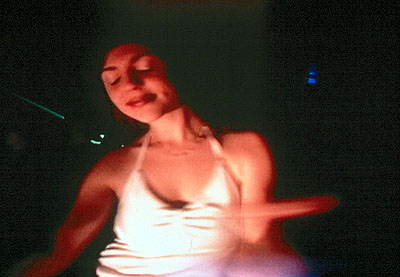Better Living Through Circuitry

To most people, techno music is something they dislike, regardless of whether or not they have actually listened to it. In recent years, techno artists such as The Prodigy, Fatboy Slim, and Moby succeeded by garnering airplay on the radio, bringing their music to the masses. Better Living Through Circuitry, the debut film from Jon Reiss, attempts to take a look at the world of techno and raves. The documentary includes interviews with renowned artists such as The Crystal Method, Carl Cox, Roni Size and DJ Keoki, interspersed with lesser-known artists such as Electric Skychurch, Heather Heart, and Frankie Bones.
Reiss and crew also interview seemingly hundreds of rave-goers and other techno artists, gathering lots of interesting information on the history and culture of the entire scene. One continually frustrating element of the documentary is Reiss' sparse use of names. A name will pop up on the bottom of the screen only once, when the person first appears. The person may appear half an hour later, with no hint as to who this person is (BT is a good example). There are people involved in the production and distribution of albums that give frequent interviews, but by the end of the movie, they are indistinguishable from teenagers attending raves. For fans of techno, putting names to some of the faces is satisfying, but most everyone else will just wonder who the speaker is.
As a documentary, Better Living Through Chemistry should serve as a primer to the world of techno, and nothing more. At times, it almost feels like a marketing tool or music video. It touches upon many subjects without going to deeply into any one of them. Most of the DJs interviewed give a short history of their careers, including their inspiration and usually a story or two about a rave, nothing that would seem out of place in a promotional package. The music is loud and frequent (which is a good thing), but Reiss chooses to film his subjects with flashy camera effects and CGI graphics, as if it were a video. It would have been much more interesting to watch the DJs at work without any of the fancy-schmancy camera angles or lights.
The most fascinating information comes from the teenagers that attend the raves. According to them, they are looking for acceptance. At a rave, no one cares what you are wearing or how you dress. They come to dance, and will ask you to join them. Everyone is welcome as they are in the large spontaneous communities. In other words, the teens of today are no different from the teens of yesterday. Now, techno replaces punk, or disco, or whatever teens use to find solace and acceptance. Then comes the hard part, sifting intelligent comments from the inane. Reiss does a fair job of this; most of the teens he interviews speak fairly intelligently, as do the DJs. Heart comments on gender inequity in the DJ business, Wolfgang Flur of Kraftwerk goes through his own discovery of drum machines, and DJ Spooky (who has degrees in philosophy and French literature) gives a fascinating comparison of his music and philosophy. Reiss also touches on the subject of drugs, however lightly. Reiss does not show the effects of ecstasy or Special K, just mentions the feelings one gets from using them. The ravers he interviews are mixed on their views of drugs, as are the DJs. Two paramedics stationed outside raves and a drug officer of the LAPD are potentially some of the more interviewing interviewees, but they only get in a sentence or two.